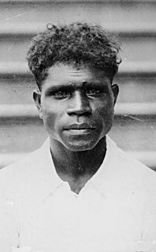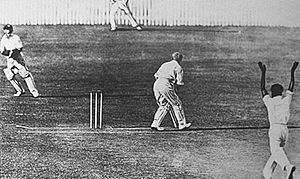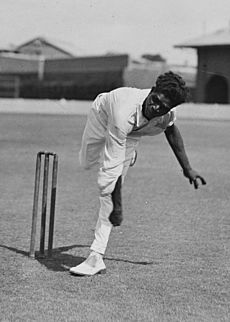Eddie Gilbert (cricketer) facts for kids
 |
|||||||||||||||||||||||||||
| Personal information | |||||||||||||||||||||||||||
|---|---|---|---|---|---|---|---|---|---|---|---|---|---|---|---|---|---|---|---|---|---|---|---|---|---|---|---|
| Full name |
Harold Edward Gilbert
|
||||||||||||||||||||||||||
| Born | 1 August 1905 Woodford, Queensland, Australia |
||||||||||||||||||||||||||
| Died | 9 January 1978 (aged 72) Wacol, Queensland, Australia |
||||||||||||||||||||||||||
| Batting | Left-handed | ||||||||||||||||||||||||||
| Bowling | Right arm fast | ||||||||||||||||||||||||||
| Role | Bowler | ||||||||||||||||||||||||||
| Domestic team information | |||||||||||||||||||||||||||
| Years | Team | ||||||||||||||||||||||||||
| 1930/31–1935/36 | Queensland | ||||||||||||||||||||||||||
| Career statistics | |||||||||||||||||||||||||||
|
|||||||||||||||||||||||||||
|
Source: CricketArchive, 12 January 2010
|
|||||||||||||||||||||||||||
Harold Edward Gilbert (born August 1, 1905 – died January 9, 1978), known as Eddie Gilbert, was an Aboriginal Australian cricketer. He played for the Queensland team in the Sheffield Shield competition. People described him as an incredibly fast bowler.
Eddie Gilbert played for Queensland between 1930 and 1936. Even the famous cricketer Don Bradman said Gilbert was the fastest bowler he ever faced. Bradman mentioned that Gilbert was "faster than anything seen from (England fast bowler) Harold Larwood or anyone else."
Contents
Eddie Gilbert's Early Life and Background
Gilbert was born near Woodford. When he was three years old, he was taken from his family. This was part of a sad time in Australian history known as the Stolen Generations. He grew up on farms while living at the Barambah Aboriginal Reserve. Today, this place is called Cherbourg.
Eddie started playing cricket when he was young. At first, he bowled slowly. But he quickly learned to bowl very fast. He said his speed came from years of hard work and practice. He had a special flexible wrist that helped him.
Eddie Gilbert's Cricket Career Highlights
Playing First-Class Cricket
- Further information: 1930–31 Sheffield Shield season, 1931–32 Sheffield Shield season, 1932–33 Sheffield Shield season, 1933–34 Sheffield Shield season, 1934–35 Sheffield Shield season, and 1935–36 Sheffield Shield season
After playing for the State Colts team in 1930, Gilbert joined the Queensland Sheffield Shield team for the 1930/31 season. He was likely only the fifth Aboriginal Australian to play first-class cricket in Australia. Other early Aboriginal players included Twopenny (1870), Johnny Mullagh (1879), Jack Marsh (1900), and Albert Henry (1902).
In his first season with Queensland, Gilbert played five out of six games. He took 15 wickets, which are like points for getting batsmen out. His best performance was taking 4 wickets for 44 runs. He had one of the best bowling averages in the competition that year.
In his second season (1931–32), Gilbert played five more matches. He took even more wickets, getting 21 in total. This greatly improved his bowling average. He also achieved his first five-wicket haul, taking 5 wickets for 67 runs against the Victoria team.
During his career, Gilbert played 19 Sheffield Shield matches. He took 73 wickets in these games. He also took 14 more wickets against visiting teams from England (MCC), West Indies, and South Africa. In one game against the West Indies, he took 5 wickets for 65 runs.
Despite his amazing skills, Eddie Gilbert was probably never considered for the Australian national team. This was partly because some people questioned his bowling style. Also, Queensland was not a very strong team at the time.
Challenges Faced by Aboriginal Players
In 1931, as an Aboriginal man in Queensland, Eddie Gilbert faced many rules. These rules were part of the Protection of Aboriginals Act 1897. This meant he needed written permission to leave his Aboriginal settlement every time he played a first-class match. Records of these permissions still exist today.
Retirement from Cricket
Gilbert stopped playing cricket in 1936 because he wasn't playing as well. After he retired, cricket officials and the Aboriginal Protectorate helped him return to an Aboriginal settlement.
Eddie Gilbert passed away on January 9, 1978, at Wolston Park Hospital near Brisbane. He was 72 years old and had been unwell for many years. Some people believed his health problems were linked to the unfair treatment he experienced. For example, he was sometimes not allowed to stay in the same rooms as his teammates. He was also forced out of the game by some who unfairly called him a cheat because of his unique bowling action.
In 2015, Eddie Gilbert's son, Barney, helped dedicate the Eddie Gilbert Memorial Field. This field is near the hospital where his father passed away. A folk singer named Dermot Dorgan also performed a tribute song about Eddie Gilbert's life.
Eddie Gilbert Dismisses Don Bradman
On November 6, 1931, Eddie Gilbert played against NSW at the Brisbane Cricket Ground (the "Gabba"). He bowled his first ball and got the opening batsman, Wendell Bill, out right away. The next batsman to come in was the legendary Don Bradman.
Bradman found Gilbert's bowling incredibly fast. The first ball was hard to hit. The second ball was harmless. But the third ball was too quick! It flew past Bradman's bat and hit the wicketkeeper's gloves with a loud thud. The fourth ball was just as fast and hit Bradman on his stomach, making him drop his bat in pain. He slowly got back up. Then came a very fast bouncer (a ball that bounces high). Bradman tried to hit it, but it was too quick. The ball flew high in the air, and the wicketkeeper caught it easily. Bradman was out!
Years later, Bradman remembered that the five balls he faced from Gilbert that day were the fastest he had ever experienced. He said, "The keeper took the ball over his head, and I reckon it was halfway to the boundary." Bradman also stated that Gilbert's balls "were unhesitatingly faster than anything seen from Larwood or anyone else." However, Bradman also mentioned in his book that he thought Gilbert's bowling action looked "decidedly suspect."
Gilbert played against Bradman two more times. He also played against Douglas Jardine during the famous 1932/33 Bodyline cricket tour.
Eddie Gilbert's Unique Bowling Style
Eddie Gilbert had a very unusual bowling action. He was only called for "throwing" (an illegal bowling action) once in his career. This was for jerking his wrist. Importantly, umpires never said his arm was bent, which is the main rule for a legal delivery. The time he was called was in a match between Victoria and Queensland at the MCG in 1931. The umpire, Andrew Barlow, called him 13 times for his action in that game.
Alan McGilvray, a famous cricket commentator, had "absolutely no doubt" that Gilbert was "the fastest bowler I ever saw." He added, "no matter how I analyse cricket down the years, I cannot imagine anybody bowling a ball faster than Eddie Gilbert." About whether Gilbert's action was legal, McGilvray said, "It was hard to tell whether he actually chucked or not, because he let the ball go with such a fling of his right arm you got precious little sight of it."
Recognizing Eddie Gilbert's Legacy
In 2007, Queensland Cricket put up a bronze statue of Eddie Gilbert. It is located on Greg Chappell Street, outside Allan Border Field in Albion. The statue was designed by Pauline Clayton. It shows Gilbert in action, bowling a ball. The monument was officially dedicated in November 2008.
Also in 2007, Indigenous Sport Queensland created the Eddie Gilbert Medal. This award recognizes Queensland's best Indigenous sports person.
See also
- List of cricketers called for throwing in top-class cricket matches in Australia
- Australian Aboriginal cricket team in England in 1868
- Twopenny - Aboriginal Australian who played for New South Wales against Victoria in 1870
- Johnny Mullagh - Aboriginal Australian who played for Victoria against the MCC in 1879
- Albert Henry - Aboriginal Australian who played for Queensland from 1902 to 1905




